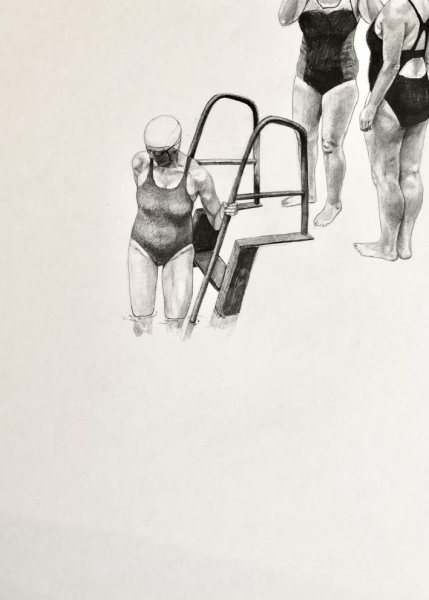At the Intersection of Art and Science
by Nina Wilder for Duke Arts
CEE PhD grad Clay Sanders shares how making art has helped his career as an engineer and provided him with an outlet during difficult times

Clay Sanders has made art for as long as he can remember. Constantly doodling and drawing as child, relishing every museum visit, he cultivated a love of art and its practice that he has retained well into his adulthood. So, it makes sense that when Sanders came to Duke in 2011 to begin his undergraduate education, he did so as a studio art major.
It is perhaps a bit more difficult to wrap your head around his first-year switch to the Pratt School of Engineering. Sanders graduated with a B.S.E. in 2015 and decided to stay at Duke to pursue a PhD in civil engineering.
But for Sanders, who graduated from his PhD program in 2020, it’s all perfectly logical—in fact, his dual fascinations with art and science have only made him a better engineer.
“A lot of people in my field come from a science and math background, but I think it’s interesting to have an artistic background when working on complex engineering problems.”
CLAY sanders, CEE PHD’20
“A lot of people in my field come from a science and math background, but I think it’s interesting to have an artistic background when working on complex engineering problems,” Sanders said. “Having those artistic sensibilities has been helpful for my science and engineering work and hopefully given me a unique perspective on how to present or visualize things.”
As a PhD candidate, Sanders studied a subfield of civil engineering called computational mechanics. The discipline, which broadly focuses on the use of computational methods to represent the mechanical behavior of anything from an automobile to a bridge, was particularly appealing to Sanders because it allowed him to maintain creativity in his work.
“Basically, I studied the question: How can you optimally design structures?” Sanders said. “The outputs are these really cool, organically-shaped structures that sometimes resemble things you would see in day-to-day life and sometimes resemble things that you would see in Star Trek or Star Wars.”
But in the spring of 2019, after he had finished his engineering classes and was working full-time on his thesis, Sanders realized that the creative opportunities in his computational work weren’t cutting it.
“I found that I needed a right-brained outlet, and painting and drawing have always been that for me,” Sanders said. “If I start a drawing, I can work on it for hours on end—the time just flies by. It’s very therapeutic for me.”
So, he signed up for Bill Fick’s Intermediate Drawing course and pushed himself, for the first time since high school, to develop his artwork thematically. He chose to draw swimmers—poised atop starting blocks, wading into the water, hanging onto floats in a wave pool. (A former member of Duke’s varsity swim team, Sanders cites swimming as another of his many passions.) After the semester ended, Fick asked him to do a painting involving dancers, to be displayed at the Rubenstein Arts Center.

And while dance is ostensibly outside of Sanders’s comfort zone—“I am a terrible dancer. I know nothing about dance,” he professed—it wasn’t a totally unfamiliar subject; pulling from his experiences  as an artist, an athlete, and a PhD candidate, Sanders decided to depict a dance rehearsal.
as an artist, an athlete, and a PhD candidate, Sanders decided to depict a dance rehearsal.
“There’s a lot of work that goes in behind the scenes before a huge performance or the final milestone presentation,” Sanders said. “Most people only see that—the final thing. I think there’s a lot of value in the work that goes into developing something.”
Still, Sanders pointed out that portraying dancers required a different artistic approach than swimmers.
“For the swimmer drawings, I tried to do groups of people. I wanted to examine how swimming is both an individual and a group activity—you’re spending hours and hours with people, but you’re really by yourself the whole time too, in your thoughts and counting laps, looking at your time,” he said. “Dance is very different, I suppose, where you’re on stage with people and you’re actually interacting with them and touching them. Your thoughts kind of have to be in tune.”
Sanders was nearly finished with Rehearsal when the COVID-19 pandemic forced students to leave campus in March 2020, with no clue as to when they’d be allowed to return. A few months later, he was able to retrieve the painting from an on-campus studio and finished it in his apartment while he wrapped up his doctoral program and prepared for his life post-Duke.
Now living in Oakland, CA, and working at Sandia National Laboratories as a Mechanical Engineer, Sanders is still involved in the computational mechanics research he conducted as a PhD candidate and hopes to continue to find ways to make his day-to-day work more creative. Above all, he’s found that art has provided a much-needed escape during the pandemic, allowing him to turn off his myriad screens, pull out some paper and paint, and focus on creating.
“It’s cool to be able to not just be a consumer of media, of images and music and art, but to try to also contribute to that body of media, to make your own images and be creative,” Sanders said. “I think that’s a natural thing for humans to do, but it is really rewarding to create rather than just consume.”
Subcribe to the Duke Arts newsletter for more stories like this.
